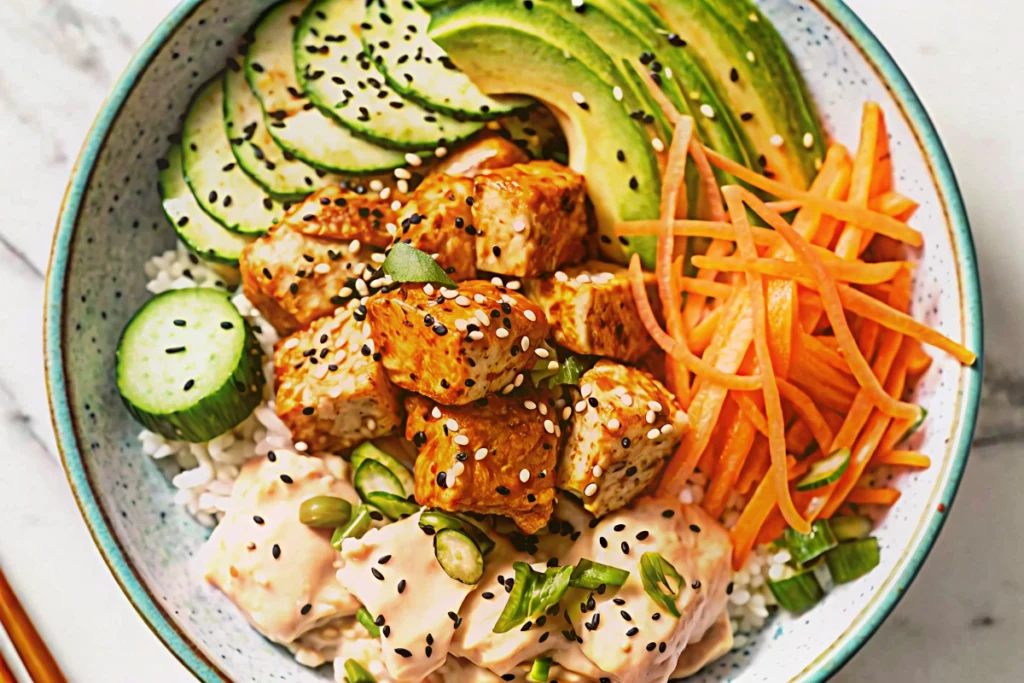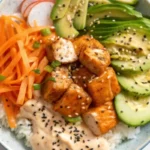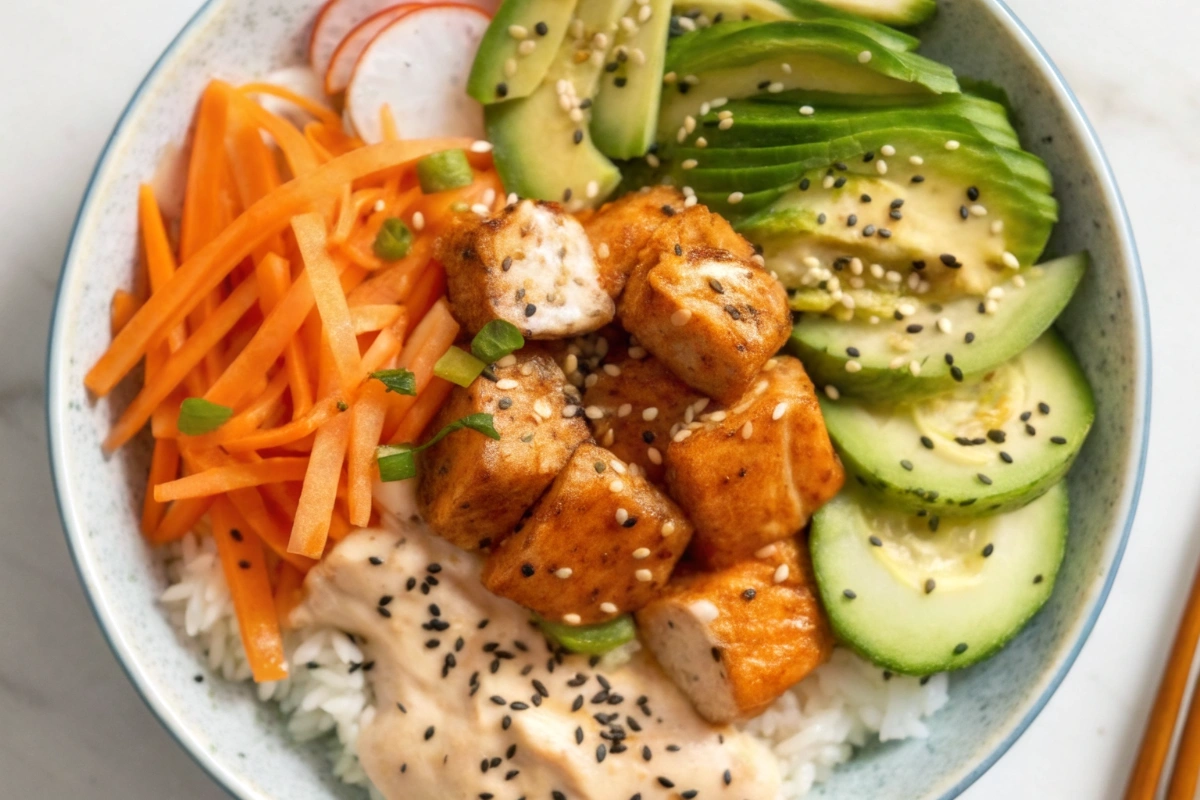Table of Contents
The salmon bowl has exploded in popularity, and for good reason. This wholesome, colorful dish is packed with nutrients, easy to customize, and irresistibly flavorful. Whether you’re looking for a post-workout protein meal or a visually stunning dinner, a salmon bowl fits the bill.
It’s also incredibly healthy. Thanks to salmon’s rich omega-3 content, it supports everything from heart health to brain function. According to Harvard’s guide to omega-3 fats, regular consumption of these fats can help reduce inflammation and lower blood pressure—making your next bowl of salmon more than just delicious.
What brings it all together? The rice. A perfect salmon bowl often begins with properly seasoned sushi rice. If you’ve never made it before, this step-by-step guide from Just One Cookbook is a great place to start.
What Is a Salmon Bowl?
A salmon bowl is a meal-in-a-bowl concept that layers a hearty base like rice or quinoa with tender salmon, vibrant vegetables, and a bold sauce. It draws inspiration from Asian cuisines like Japanese donburi and Hawaiian poke, but offers limitless customization.
Key components typically include:
- Grilled, baked, or raw salmon
- A base of sushi rice, brown rice, or cauliflower rice
- Vegetables like cucumber, avocado, and edamame
- Sauces such as soy sauce, sriracha mayo, or ponzu
Health Benefits of Salmon Bowls
A well-built salmon bowl is more than a tasty dish—it’s a nutritional powerhouse. Here’s why:
- High in protein: Helps build muscle and keeps you full longer
- Rich in omega-3 fatty acids: Supports heart, brain, and joint health
- Loaded with fiber: Thanks to greens, seaweed, and legumes
- Packed with antioxidants: From ingredients like mango and pickled ginger
According to the USDA FoodData Central, salmon is one of the most nutrient-dense proteins available, offering B vitamins, selenium, potassium, and more in just a few bites.
Key Components of a Salmon Bowl

To create a well-balanced salmon bowl, you’ll want to include the following:
Base
- Sushi rice – sticky and slightly sweet
- Brown rice – nutty and rich in fiber
- Cauliflower rice – perfect for low-carb diets
- Quinoa – adds a nutty flavor and is gluten-free
Protein
- Grilled salmon
- Baked teriyaki salmon
- Sashimi-grade raw salmon
- Smoked salmon
Toppings
- Avocado
- Edamame
- Pickled radish
- Cucumber
- Seaweed salad
- Mango
- Carrots
- Green onions
- Sesame seeds
Sauces
- Spicy mayo (sriracha + mayo)
- Soy sauce or tamari
- Ponzu
- Miso vinaigrette
How to Make a Salmon Bowl at Home
Here’s a simple way to assemble a restaurant-quality salmon bowl right in your kitchen:
Ingredients:
- 1 fillet of salmon
- 1 cup cooked sushi rice
- ¼ cup edamame, shelled
- ½ avocado, sliced
- ¼ cup cucumber, thinly sliced
- 2 tbsp spicy mayo
- 1 tsp sesame seeds
- Optional: pickled ginger, seaweed salad, or mango
Instructions:
- Cook the base
- Prepare sushi rice and season with vinegar, sugar, and salt.
- Prepare the salmon
- Grill, bake, or marinate raw salmon for poke.
- Slice or cube depending on preference.
- Layer the bowl
- Start with the rice, add your salmon, and pile on your toppings.
- Top it off
- Drizzle your sauce of choice and sprinkle sesame seeds.
Popular Salmon Bowl Variations
Want to switch it up? Try these delicious spins:
1. Classic Teriyaki Salmon Bowl
- Grilled teriyaki salmon
- Steamed rice
- Broccoli, carrots, and scallions
- Sesame seeds and ponzu drizzle
2. Spicy Poke Salmon Bowl
- Raw salmon cubes in spicy mayo
- Avocado, cucumber, pickled ginger
- Sushi rice and crispy onions
3. Keto Salmon Bowl
- Grilled salmon over cauliflower rice
- Avocado, spinach, and sesame oil
- Topped with pumpkin seeds
Salmon Bowl Nutrition Facts
A standard salmon bowl typically contains:
- Calories: 500–700
- Protein: 25–35g
- Fat: 20–30g (healthy fats from salmon and avocado)
- Carbs: 30–50g (mostly from rice and sauces)
Tip: Go easy on creamy sauces and monitor rice portions to reduce calorie load.
Customizing to Dietary Needs
Whether you’re vegan, gluten-intolerant, or low-carb, the salmon bowl can be adapted to suit your needs:
- Gluten-Free: Use tamari instead of soy sauce
- Keto/Low-Carb: Swap rice for cauliflower rice and skip sugary sauces
- Vegan: Replace salmon with tofu, tempeh, or jackfruit
- Dairy-Free: Avoid creamy sauces; opt for vinaigrettes
Trending: Salmon Bowls on Social Media

On platforms like TikTok and Instagram, salmon bowls have become a viral sensation. Trends include:
- “Emily Mariko” salmon rice bowl with seaweed and sriracha mayo
- Deconstructed sushi bowls
- Meal prep-friendly bentos with colorful toppings
The appeal? A mix of health, aesthetics, and ease of assembly.
Restaurant vs Homemade: Which is Better?
| Feature | Restaurant | Homemade |
|---|---|---|
| Cost | $12–$18 | $4–$7 |
| Customization | Moderate | Complete control |
| Ingredient Quality | Varies | You choose organic/local |
| Freshness | Hit-or-miss | Always fresh |
Homemade salmon bowls offer better value, fresher ingredients, and infinite creativity.
Common Mistakes to Avoid: Salmon Bowl
Making a salmon bowl sounds easy, but here are pitfalls to watch out for:
- Overcooking the salmon – It should be flaky and moist
- Using low-quality rice – Invest in short-grain sushi rice
- Overloading flavors – Keep sauces balanced
- Skipping seasoning – Season both the rice and the protein
FAQs
Q1: Can I use canned salmon in a salmon bowl?
Absolutely. Canned salmon is a convenient and budget-friendly option, especially for quick meal prep. It’s already cooked and typically rich in omega-3s. Just be sure to:
- Drain it thoroughly
- Remove any skin or bones (unless you prefer them)
- Season it to enhance the flavor
It’s a great substitute for grilled salmon and works well in spicy salmon bowls or low-carb versions.
Q2: What’s the best rice for a salmon bowl?
The gold standard is short-grain sushi rice due to its sticky texture and ability to hold together when scooped. However, alternatives include:
- Brown rice for a higher fiber content
- Cauliflower rice for keto or low-carb diets
- Quinoa for a gluten-free, high-protein option
Make sure to rinse rice before cooking to remove excess starch and get that perfect fluffy bite.
Q3: Are salmon bowls safe during pregnancy?
Yes—if the salmon is fully cooked. Pregnant individuals should avoid:
- Raw or undercooked salmon (risk of parasites or bacteria)
- High-mercury fish (which salmon is not)
For a pregnancy-safe bowl: - Use grilled, baked, or pan-seared salmon
- Skip raw sauces with unpasteurized eggs (like some spicy mayos)
Always consult your doctor if you’re unsure.
Q4: Can I meal-prep salmon bowls in advance?
Definitely. Salmon bowls are ideal for meal prepping. Here’s how to do it right:
- Cook and store components separately (rice, salmon, veggies)
- Use airtight containers to keep items fresh
- Add sauces just before eating to prevent sogginess
- Grilled salmon holds up best for 3–4 days in the fridge
They make for perfect weekday lunches or easy dinners.
Q5: What’s the difference between a salmon bowl and a poke bowl?
- A salmon bowl is a general term that may include grilled, baked, or raw salmon, and draws influence from global cuisines.
- A poke bowl specifically refers to raw marinated fish (often tuna or salmon) and hails from Hawaiian culinary tradition.
Key differences: - Salmon bowls are more flexible and can be hot or cold
- Poke bowls are traditionally cold and raw, with Asian-Pacific toppings like seaweed, soy sauce, and sesame oil
Q6: Can I make a vegan version of a salmon bowl?
Yes! Swap the salmon for:
- Marinated tofu
- Tempeh
- Jackfruit
- Roasted chickpeas
Pair it with rice, veggies, and plant-based sauces like miso vinaigrette or tahini dressing. You’ll still get the flavor and nutrition in a plant-powered package.
Q7: How do I know if raw salmon is safe to eat?
Only use sashimi-grade salmon or sushi-grade salmon from reputable sources if you plan to serve it raw. Safe practices include:
- Buying from trusted fishmongers or specialty markets
- Freezing the salmon at -4°F (-20°C) for at least 7 days to kill parasites
- Consuming it within 24 hours of preparation
When in doubt, go with cooked salmon for peace of mind.
Conclusion
A salmon bowl is one of the most balanced, beautiful, and satisfying meals you can make. It’s endlessly customizable, quick to prep, and loaded with flavor and nutrition. Whether you’re watching your macros, trying to eat cleaner, or just love good food, this bowl is your new best friend.
So the next time you’re planning dinner, skip the takeout and make your own salmon bowl—your tastebuds (and body) will thank you.
Print
BEST Salmon Bowl EVER
- Total Time: 20 minutes
- Yield: 1 serving 1x
Description
A nourishing and flavorful bowl featuring tender salmon, sushi rice, and fresh vegetables—perfect for a balanced meal.
Ingredients
- 1 fillet of salmon
- 1 cup cooked sushi rice
- ¼ cup edamame, shelled
- ½ avocado, sliced
- ¼ cup cucumber, thinly sliced
- 2 tbsp spicy mayo
- 1 tsp sesame seeds
- Optional: pickled ginger, seaweed salad, or mango
Instructions
- Cook the salmon in a skillet or oven until fully cooked and golden.
- Place the cooked rice at the bottom of a serving bowl.
- Add edamame, avocado, cucumber, and salmon on top.
- Drizzle with spicy mayo.
- Sprinkle with sesame seeds.
- Add optional toppings to taste.
Notes
Use fresh, high-quality salmon for best results. Feel free to customize with your favorite toppings.
- Prep Time: 10 minutes
- Cook Time: 10 minutes
- Category: Bowl
- Method: Stovetop or Oven
- Cuisine: Asian Fusion
Nutrition
- Serving Size: 1 bowl
- Calories: 520
- Sugar: 4g
- Sodium: 480mg
- Fat: 30g
- Saturated Fat: 5g
- Unsaturated Fat: 22g
- Trans Fat: 0g
- Carbohydrates: 35g
- Fiber: 5g
- Protein: 32g
- Cholesterol: 70mg
Keywords: salmon bowl, sushi rice, healthy bowl, salmon recipe

